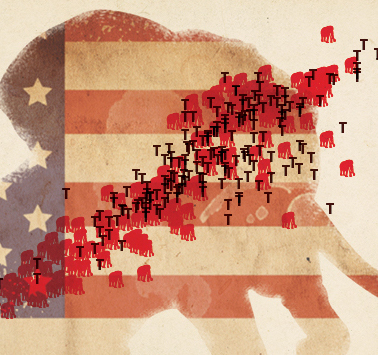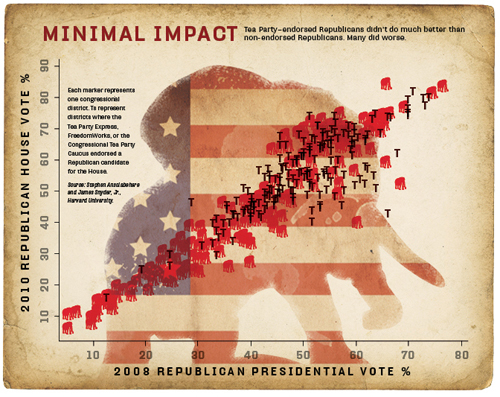The rise of the Tea Party was one of the signal storylines of 2010. The movement attracted money, activists, and endorsements from high-profile politicians, especially Sarah Palin. And it reputedly broadened the appeal of the Republican Party beyond its usual base, siphoning from the Democrats many middle- and even working-class Americans. If the mainstream narratives are right, the Tea Party is primed to continue shaking up the political landscape as the 2012 election nears.
Yet the Tea Party, despite the media sensation it has generated, does not seem to have boosted the vote of candidates it supported. In the 2010 midterm, the Tea Party—via the two major national groups, Tea Party Express and FreedomWorks, and the congressional Tea Party Caucus—endorsed Republicans in Republican districts, and those Republicans performed about as expected. These factors, largely missed in commentaries on the movement and its implications for 2012, suggest that the Tea Party may not have much traction, at least in future general elections.
It is tempting to believe that the Tea Party endorsement moved voters. Indeed, the candidates endorsed by these groups did well: 64 percent of Republican candidates endorsed by the Tea Party Express or FreedomWorks (or both) won, while only 52 percent of non-endorsed Republicans won. The numbers look even more impressive among non-incumbents: almost 52 percent of endorsed candidates won, while only 28 percent of non-endorsed candidates won.
But there is less to these numbers than meets the eye. The Tea Party endorsers played with a stacked deck, tending to support Republican candidates in Republican-leaning districts more than in Democratic-leaning districts. In the 200 most Republican districts (based on the 2008 presidential election results), at least one of the national Tea Party groups endorsed the Republican candidate 43 percent of the time. In the 200 most Democratic districts, at least one of these groups endorsed the Republican candidate only 35 percent of the time. The skew is even larger for non-incumbents: in the 200 most Republican districts, the Republican candidate was endorsed 55 percent of the time, while in the 200 most Democratic districts, the Republican was endorsed only 34 percent of the time. Five of the endorsed candidates had no Democratic opponent.
The penchant for endorsing candidates in Republican-leaning areas almost completely explains the Tea Party’s success rate. The graph, “Minimal Impact,” shows the tight relationship between Republican share of the House vote in 2010 and Republican share of the presidential vote in 2008. One may think of this graph as relating what we naively expected in 2010 (based on the 2008 results) to what actually happened. Those races in which a Republican received the endorsement of one of these Tea Party organizations are marked with a T, and those Ts are overwhelmingly on the right side of the graph, meaning that Tea Party endorsements of Republicans were most common in those districts that probably would have voted for Republicans anyway.
If endorsements from the movement’s organizations mattered substantially, then the Ts would deviate in the Republican direction (upward). Some of the endorsees did better than expected; that is, they ran ahead of other Republicans in similar districts. However, many ran behind their party, and some far behind. To isolate the Tea Party effect, we compared the performance of Tea Party–endorsed Republicans with non-endorsed Republicans running in similar districts. That effect is a statistically insignificant three-tenths of one percent.
A similar analysis for the Senate is more speculative because there were many fewer races. But in those races, Tea Party endorsees ran three percentage points behind non-endorsed Republicans running in similar states.
So while the large number of victories for Tea Party–backed candidates suggests electoral appeal and political clout, it seems that a Tea Party endorsement actually didn’t matter all that much. In an election year that favored Republican politicians because of the prolonged economic recession and stubbornly high unemployment, Republican politicians did about as well as one would expect.
But even if the Tea Party endorsement carried little additional punch, perhaps the movement infused new money into politics? It doesn’t seem so. About $2 billion were spent on federal elections in 2010. According to the Federal Election Commission’s records, the Tea Party Express outdid all other Tea Party groups by raising $7.7 million. An impressive number, but hardly decisive given the total spending, and even less so given that the organization spent only $1.2 million of that on direct contributions or independent expenditures. The rest was devoted to overhead and fundraising events. Such high expenditures on maintenance and operation are typical of non-connected, ideological political action committees. For example, the National Conservative Political Action Committee became famous for targeting six vulnerable Democratic senators in 1980, all of whom ultimately lost. Yet it had similarly high overhead and fundraising expenditures and, by mid-decade, was history.
The other reputed channel of Tea Party money ran through local organizations. But there, too, the amounts are underwhelming. According to a Washington Post survey of local Tea Party organizations, the median amount a local group raised in 2010 was $800, and the median amount of cash-on-hand was $500.
This is not the picture of a political faction awash in cash funneled from wealthy individuals and corporate interests, as was commonly portrayed in media accounts. Rather, it is of a grass-roots movement faced with heavy overhead for operations at the national level and starved for cash at the local level. Nor is it the picture of an independent political movement that brought a surge in electoral support to the candidates it endorses. Rather, the Tea Party appears to have ridden the 2010 Republican wave more than created it.









